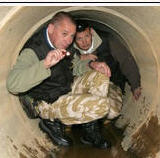Praia da Luz: More than Madeleine McCann
Page 1 of 1 • Share
 Praia da Luz: More than Madeleine McCann
Praia da Luz: More than Madeleine McCann
Visit Portugal
Praia da Luz, More Than Madeline McCann
Published one month ago
If you’re up to date with the latest Netflix series, then you’ve likely heard of Praia da Luz in Portugal. “The Disappearance of Madelina McCann” has got everyone talking, but there is certainly more to this Portuguese town than the sad story of this missing girl.
Located in the glorious southern Algarve region of Portugal, Praia da Luz is a small, beachside resort town offering visitors a combination of everything we love about Portugal – great food, great weather, and great beaches.
Praia da Luz
The town has evolved from strong fishing roots to a predominantly tourist-run town today, with many tourist developments extending over the hills.
While the resorts and hotels are certainly upgrading, the city retains many of the Portuguese charms in its family-run restaurants, beach bars, and historic centre.
It is a relaxing and welcoming destination, great for hot summer days, read on to see why!
Where is Praia da Luz in Portugal?
Praia da Luz or “Luz” is a civil parish 6 kilometres west of Lagos in the Algarve in Portugal. The town’s population is less than 5,000 people over an area of 21.78 square kilometres.
Getting to Praia da Luz
There are several easy ways to reach Praia da Luz in Portugal. The closest airport is Faro, and from Faro you can reach Praia da Luz by train, bus or car. The journey will take around 1 hour by car and 3 hours by bus/train.
If making the journey from Portugal’s capital Lisbon, you can travel by train, bus or car. Your travel time will be approximately 3 hours by car or 5-6 hours by bus or train.
Praia da Luz Beach
Since Praia da Luz is, in fact, a beach resort, it is situated on the coastline of a beautiful beachfront. The sandy beach is nestled between the Rocha Negra headline and rocky coastline of Fortaleza da Luz. Visitors can enjoy soft, golden sand and clean beach water for swimming; with lifeguards on duty in the summer.The sea waters are calm and generally safe, suitable for children to swim in. In the summer months, there are also numerous beach activities on offer, including banana boats, kayaking, paddle boarding, scuba diving, and more.
Conveniently, there is also a selection of beach cafes and restaurants nearby the beach, perfect for a midday snack or sunset dinner.
Further west of Fortaleza da Luz, you can find another beach, Praia Prainha, which is much quieter than Praia da Luz. If you want to surf, you can head east to Porto de Mós, which has better and more consistent waves for surfing. There is also a surf shop for board and wetsuit hire.
Weather in Praia da Luz
The tourist season in Praia da Luz kicks off in June and lasts until around August, with average temperatures of 22-26 degrees. The weather is also suitable for beach days from May until late September.
The resort town “closes” for winter, but there are many locals and expats who keep the town alive during these months. Winter in Praia da Luz is mild, with temperature averages of 14 degrees, but the town also experiences many rainy days.
Things To Do in Praia da Luz
Besides beaches and relaxing, there is not a whole lot else to do in Praia da Luz in Portugal. Outdoor enthusiasts can find plenty of activities while others can head into Lagos for shopping and more wild nightlife.
You can also find two of Portugal’s best golf courses nearby. There is Boavista, an 18-hole championship course, and Golf Santo António, another 18-hole course set within the Parque da Floresta.
History lovers will also find some ruins of Roman baths from the 3rd to 5th century AD behind the wall of the town’s promenade. You can enter from 10 am to 5 pm each day.
For families travelling with children, the Lagos Zoo and Slide and Splash fun park are both nearby and can be an exciting way to spend a day.
Hotels in Praia da Luz
There has been lots of property development in Praia da Luz over recent years, offering visitors a large selection of accommodation options, including hotels and holiday rentals. Here are some of the best accommodation options in Praia da Luz:
- Luz Ocean Club (Contact the club for prices) – The club resort is set amongst tropical gardens, in the heart of the resort town. Accommodation options include self-catered cottages or apartments walking distance from the beach. Other features include five tennis courts, bicycle rental, group tour bookings, restaurants, bars, spa treatments, and kids clubs.

The Disappearance of Madeline McCann
On the evening of May 3rd, 2007, three-year-old Madeleine McCann disappeared while on a family holiday at a resort in Praia da Luz. Netflix has released a documentary investigating the disappearance of Madeleine McCann, which remains a mystery to this day, twelve years later.
Madeleine was on holiday from the UK with parents Kate and Gerry McCann and her two siblings. On the evening of her disappearance, Madeleine was left asleep in their holiday apartment, while the parents dined in a nearby restaurant. At approximately 10 pm, Madeleine was declared missing.
Over the course of weeks, months, and years, many investigations by both Portuguese and British police were carried out. The McCanns were given suspect status in September 2007, which was later removed due to lack of evidence.
The disappearance has since become the most heavily reported missing person case in modern history; attracting sustained international interest and media coverage.
The McCann family still has hope that their daughter, who would now be 15 years old, is still alive.
If you have any information, visit Find Madeline or contact:
- Email: investigation@findmadeleine.com
- Investigation Line: +44 845 838 4699
https://beportugal.com/praia-da-luz/
____________________
“ The secret of life is honesty and fair dealing. If you can fake that, you've got it made" - Groucho Marx

Verdi- ex forum manager

- Posts : 34684
Activity : 41936
Likes received : 5932
Join date : 2015-02-02
Location : Flossery
 Re: Praia da Luz: More than Madeleine McCann
Re: Praia da Luz: More than Madeleine McCann
September 2020
BY LUÍS AZEVEDO RODRIGUES
All the multicoloured layers of Praia da Luz are pages of a book, in which each page tells us a moment of the geological history of the Algarve.
The multicoloured rock sequences reveal the composition of the sedimentary rocks. Still, they also show us 120 million years of history, stories of advances (transgressions) and retreats (regressions) from the sea, a coastline that is constantly changing. The strata of fine sediments, such as marl and clay (green, red and violet tones) were deposited in environments further from the coastline.
In contrast, the sandstones (yellow tones), where, for example, we can observe the Nerineas (fossil shells), and are sediments deposited near the shoreline height, in an environment similar to a beach.
Next Article
from 'Tomorrow Aljezur to Lagoa - May 2021'
Article from: Tomorrow Aljezur to Lagoa - May 2021
Spa Day
BY LUÍS AZEVEDO RODRIGUES
All the multicoloured layers of Praia da Luz are pages of a book, in which each page tells us a moment of the geological history of the Algarve.
The multicoloured rock sequences reveal the composition of the sedimentary rocks. Still, they also show us 120 million years of history, stories of advances (transgressions) and retreats (regressions) from the sea, a coastline that is constantly changing. The strata of fine sediments, such as marl and clay (green, red and violet tones) were deposited in environments further from the coastline.
In contrast, the sandstones (yellow tones), where, for example, we can observe the Nerineas (fossil shells), and are sediments deposited near the shoreline height, in an environment similar to a beach.
The cliffs of beautiful coloured layers close to which we now place our towel were once a deep seabed or a coastal area close to the continent of that time, or even a beach environment. How do we know this? We can see this from the characteristics of the rocks, for the size and types of its minerals, and its colours.
If we walk east, with the sea on the right, we reach the natural limit of Praia da Luz, a dark rocky barrier, almost black in some places, that almost prevents the walk. This barrier is Ponta das Ferrarias, popularly called Rocha Negra (Black Rock).
These are the remains of an ancient volcano, which was created around 70 million years ago, making it the same age as the Monchique formation, which is not volcanic. Despite not being as big or impressive as Vesuvius or Etna, we are still able to recognise part of the walls of the Luz volcano dating from the upper Cretaceous. This period of the earth's history immediately follows the famous Jurassic.
WHAT DO THE VOLCANIC REMAINS TEACH US AT PRAIA DA LUZ?
Approximately 70 million years ago, the Iberian Peninsula continued to be a "stone raft", relatively isolated from the rest of the European continent and increasingly far from the American continent. These paleogeographic changes, which have been accentuated for some tens of millions of years, are the consequence of the removal of the tectonic plates that precipitated the opening of the Atlantic Ocean.
If we press a chocolate gateau, whose exterior is solid, but whose interior is in a liquid state, the filling will come out, and we will be left with a plate of varied textures. This also happened about 70 million years ago in various parts of the Iberian Peninsula. With the great tectonic movements, several zones of weakness were created, which, as in the cake analogy, caused melting material from the Earth's interior to ascend to the surface. It was these materials that gave rise to the Rocha Negra volcano and the other smaller volcanic structures, such as the one that exists right in the centre of Vila da Luz, in a garden of a private house.
AND THE FOSSILS, WHAT GEOLOGICAL STORIES TELL US?
At Ponta da Calheta, on the west end (the right side of those looking at the sea), there is a mega-concentration of fossils - the gastropod Nerinea algarbiensis. The fossils of these animals are found in yellowish sandstones, in large quantities, and it is possible to observe that many of them are aligned. This fact is an indicator of the tidal movements of the upper Cretaceous, with a different coastline than the current one, since the tidal movement caused the alignment of its shells.
If we close our eyes, we may still be able to imagine these seas and coasts of 120 million years ago, when the Nerineas' habitat was close to the coast and where their shells are now deposited.
These are some of the stories that the geology and palaeontology of Praia da Luz have to tell us.
Luís is a Palaeontologist (PhD) and Executive Director of the Ciência Viva Centre in Lagos, lrodrigues@cienciaviva.pt
Scientific Tourism of the Ciência Viva de Lagos Center
The Ciência Viva Centre in Lagos accepts bookings for guided visits either to Praia da Luz or to the dinosaur footprints of Praia Santa or Praia da Salema. Groups / families up to 8 people.
The Centre also organises the same type of visits to the dinosaur footprints of Praia Santa and the footprints of Praia da Salema. www.lagos.cienciaviva.pt
Video produced by the Ciência Viva Centre of Lagos on Praia da Luz: www.bit.ly/325iHZp
Luz's Explosive Secret
BY SOPHIE SADLER
It was during lock-down that I was invited by a lady resident of Parque de Praia in Luz, to see a small mound. She had been told by a visiting geologist that it had volcanic origins and asked Tomorrow to investigate.
Being quite frankly glad to get out of the house, I went to view the site. Father Rob Kean kindly let me into his garden to view the mound, which adjoins his garden. I had previously never taken notice of this small hill but sure enough, recalling my geography A-level days; it did look like an off-shoot of the volcano, we know existed here that formed Rocha Negra.
My curiosity ignited I made it my lock-down mission to find out the truth. At this time, I was interviewing the director of the Lagos Science Museum, Luis Azevedo Rodrigues, for the story on his production of COVID-19 masks. I found the hillock on Google Earth and sent the image to him. He put me in touch with a volcanologist who wrote to me:
"The so-called Rocha Negra is in fact of magmatic origin. It consists of several pulses of magmatic activity with a composition similar to basalts. It also shows typical geological features that are likely to find in volcanic vents. So, it is more likely to be the feeder of a possible volcano that was between two to three km above. If a volcano was constructed, all the typical features (cone, crater, etc.) were eroded.
Typically, this type of igneous activity is prone to offshoots, and the place that is shown in the Google Earth image is precisely one of these offshoots. It has been recognised in the geological history of the region (indicated by the arrow in the image attached)."
Case concluded! Luis kindly has written the fascinating article on the geology of Praia da Luz to accompany this discovery. I hope you find it as intriguing as I did.
https://issuu.com/tomorrowalgarve/docs/tomorrow_-_september_2020_edition_web/s/10907174
____________________
“ The secret of life is honesty and fair dealing. If you can fake that, you've got it made" - Groucho Marx

Verdi- ex forum manager

- Posts : 34684
Activity : 41936
Likes received : 5932
Join date : 2015-02-02
Location : Flossery
 Similar topics
Similar topics» Ten years after Madeleine McCann's disappearance in Praia da Luz in the Algarve, the British authorities keep the case open and continue to search for the child.
» The SIX PHOTOS that provide the biggest clue to when Madeleine died
» KATE MCCANN'S PORTUGAL RETURN (Merged thread Daily Star and Mirror articles)
» Daily Star: Madeleine McCann cops tracing 13 KEY SUSPECTS seen acting suspiciously in Praia da Luz
» The Sun: MISSING SCENE Where did Madeleine McCann disappear and where is the Ocean Club apartment in Praia da Luz Portugal?
» The SIX PHOTOS that provide the biggest clue to when Madeleine died
» KATE MCCANN'S PORTUGAL RETURN (Merged thread Daily Star and Mirror articles)
» Daily Star: Madeleine McCann cops tracing 13 KEY SUSPECTS seen acting suspiciously in Praia da Luz
» The Sun: MISSING SCENE Where did Madeleine McCann disappear and where is the Ocean Club apartment in Praia da Luz Portugal?
Page 1 of 1
Permissions in this forum:
You cannot reply to topics in this forum
































